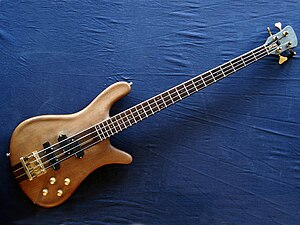Streamer Bass

Streamer from 1983
|
|
| Manufacturer | Warwick |
|---|---|
| Period | 1982–present |
| Body type | Solid |
| Neck joint | Set-in |
| Body | Mahogany (often with a maple top), |
| Neck | Mahogany, maple |
| Fretboard | Rosewood, ebony, maple |
| Bridge | Usually hardtail (Tune-O-Matic) |
| Pickup(s) | Usually J |
| Burst, Natural, Satin | |
The Streamer bass is a bass guitar manufactured by the Warwick company and launched in 1982.
The design was changed around 1985 to be replaced with the current style headstock, and the original one piece bridge was later changed to the two piece style seen in current Warwick basses. Since the 1990s, Streamer basses have used MEC pickups and electronics (on certain models, most often on Limited and Special Edition series, Seymour Duncan and Bartolinis are used).
The Streamer LX was added to the Warwick roster in 1996. The 4-string Streamer LX is equipped with a P/J-pickup configuration, the 5-string it equipped with a J/J-configuration and the 6-string is equipped with a dual humbucker setup. Like most Warwicks, the Streamer LX is constructed with some unusual woods - a two piece Flame Maple body, a bolt on Ovankol neck and a Wenge fingerboard.
The Streamer Jazzman was created in 2000. After the Warwick FNA Jazzman was created in 1999, Warwick decided it was necessary to make the Streamer version. The Streamer Jazzman earned its name because of its pickup configuration; a slanted Jazz Bass pickup near the neck and a Music Man humbucking pickup near the bridge.
It was well documented that the first versions of the Streamer were near exact copies of the NS-Bass. The Spector NS-Bass was designed by Ned Steinberger for Stuart Spector in 1977, five years before Warwick was formed.
In the May 2012 article titled "Meet Your Maker: Hans Peter Wilfer of Warwick", an interview with Warwick founder and CEO in Bass Player, the following history is given explaining Wilfer's decision to make copies of the highly sought-after Spector NS-Bass: "'We didn’t see any reason to build Fender copycats, which players could get easily and cheaply from Asia, so we decided to focus only on high-end, innovative instruments.' In the mid ’80s, the Spector NS was tracking well in the U.S., but these basses proved hard to come by in Europe. H.P. saw that problem as a potential solution for the direction of his company and took up the task of designing his own version of this popular, ergonomically friendly instrument. That venture resulted in Warwick’s first widely successful instrument: the Streamer Stage I."
...
Wikipedia
